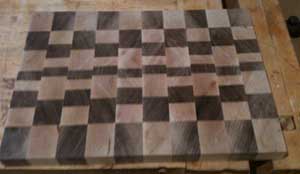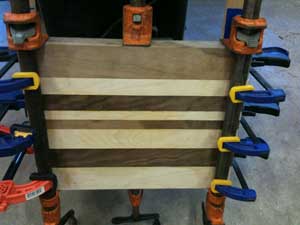First things first – I’m not a woodworker. Actually, I WASN’T a woodworker. Longtime followers of the blog know that while I certainly appreciate the beauty, precision and creativity of this craft, I haven’t been someone that uses wood to make things that look good, serve a purpose, or both.
That all changed a couple months ago. Long story short, I decided that after almost four years of working with some pretty amazing woodworkers, it was time to join the party.
 I started out with the old “first project” standby by making a cutting board. However, this wasn’t just any cutting board – it was the Butcher Block Cutting Board that I remember seeing on the Wood Whisperer site a long time ago. The contrasting wood design caught my eye, but the use of end grain on the cutting surface – which is much better for knives and provides a more durable cutting board – made me wonder how I could ever use anything else ever again. So I went to work.
I started out with the old “first project” standby by making a cutting board. However, this wasn’t just any cutting board – it was the Butcher Block Cutting Board that I remember seeing on the Wood Whisperer site a long time ago. The contrasting wood design caught my eye, but the use of end grain on the cutting surface – which is much better for knives and provides a more durable cutting board – made me wonder how I could ever use anything else ever again. So I went to work.
A couple things I learned along the way:
#1 – The importance of dry fitting before glue-up.
#2 – Keep your mind on the project at hand.
 These are standard instructions I’ve seen in just about every one of the project articles I’ve read, but as many times as I’ve seen or heard them, they didn’t sink in until I learned the lessons first-hand.
These are standard instructions I’ve seen in just about every one of the project articles I’ve read, but as many times as I’ve seen or heard them, they didn’t sink in until I learned the lessons first-hand.
I was in a hurry to get the pieces glued together during the first glue-up so I could move on to a couple other projects during my limited shop time. The result? I skipped the step that would have clearly shown me that I had arranged the pieces in the wrong order. Now, instead of clean lines between the contrasting wood and a uniform design throughout the board, I’ve got a fairly abstract orientation of pieces. Fortunately, the board has actually been cut in two with one half going to my grandmother and one to my mom as Christmas presents (shhh…. don’t tell). To them, there’s no such thing as a mistake and anything I make belongs in a museum.
Plus, the benefits of the end grain cutting surface didn’t get lost and the maple and walnut I used still look great. Lesson Learned #3: Use the best stock possible.
What are your stories for lessons learned the “hard” way?
Matt Becker
Internet Production Coordinator






